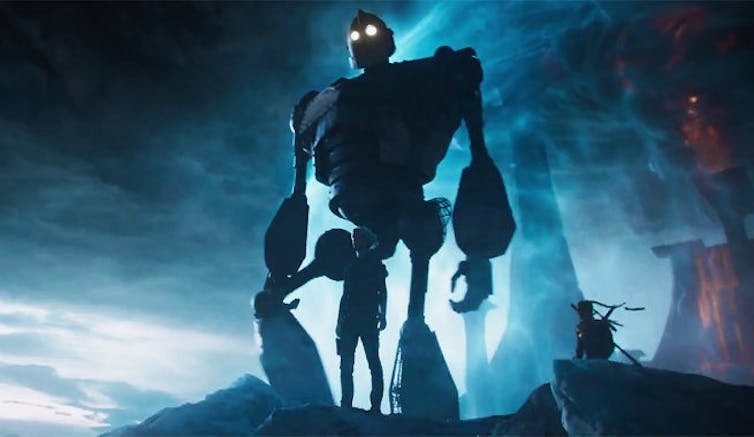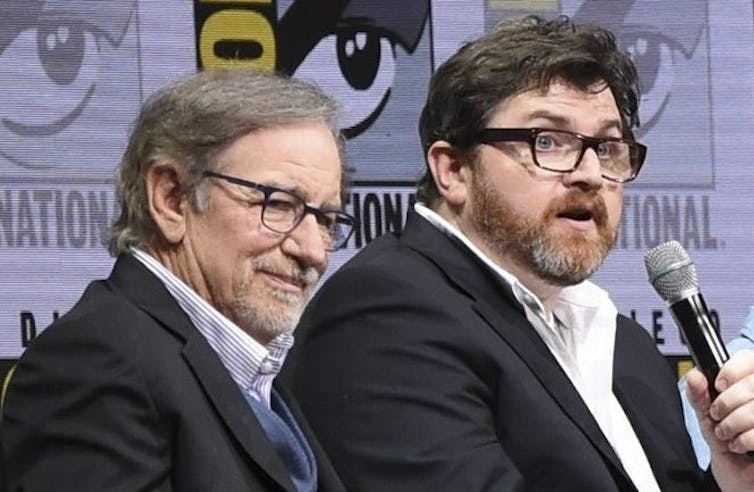About the author: Tom Ue researches and teaches courses on nineteenth-century British literature, intellectual history, and cultural studies at Dalhousie University.
Dystopian fiction seems so alluring during the coronavirus pandemic. As we eagerly await a return to normalcy, many say we can aspire to do better — whether we are talking about wealth distribution or global warming. What dystopian fiction does especially well is to show how we can do more than simply repeat.
Steven Spielberg’s Ready Player One (2018), an adaptation of Ernest Cline’s bestselling novel of the same title (2011), is a case in point. Set in 2045 in the city of Columbus, Ohio, it speaks of a world that has weathered corn syrup droughts and bandit riots.
People have now resorted to outliving rather than fixing the world’s problems. Accordingly, a virtual reality game known as the OASIS has become a refuge for many, including the central protagonist Wade Watts (Tye Sheridan).
Small wonder that the OASIS is so appealing. Within its walls, Spielberg pays homage to many aspects of popular culture. The video game Minecraft (2009) is a possible setting, and throughout the film, viewers watch Chucky, the Iron Giant and Mechagodzilla in battle.

Refuge of virtual reality
Entire plot sequences incorporate existing popular characters, music and stories. In a nod to Superman, Watts dons Clark Kent glasses to conceal his identity. And in a sequence worthy of the film’s 2019 Academy Award nomination for Achievement in Visual Effects, Watts and his romantic interest Samantha Cook (Olivia Cooke) dance to the Bee Gees’ “Stayin’ Alive” (1977).
The central conflict in Ready Player One arises when James Halliday (Mark Rylance), one of the OASIS’s creators, dies and leaves behind a seemingly impossible quest. The prize is his extensive fortune and total control over the OASIS. Watts’ competitors include the Innovative Online Industries (IOI), a loyalty centre that seeks to take over the OASIS.
The IOI is shown to be exploitative. Samantha’s father, we learn, borrowed gaming gear, built up debt and moved into the IOI in hopes to repay it, only to fall ill and die. Samantha stands to follow his example and her debt has already exceeded 23,000 credits.
Inequalities
What distinguishes the film — and its source material — is its exploration of how we negotiate with a social order rife with inequalities. This theme is particularly timely: COVID-19 has made apparent, for instance, the links between inequality and public health.
In the novel, the IOI’s corporate police arrest Wade, and he is marshalled out of his apartment complex and into a transport truck. As the vehicle moves, he peers out of its window and absorbs the changes that have befallen the world:
“A thick film of neglect still covered everything in sight …. The number of homeless people seemed to have increased drastically. Tents and cardboard shelters lined the streets, and the public parks I saw seemed to have been converted into refugee camps.”
The key term here is neglect. Wade is not alone in having forsaken the world. The virtual universe of the OASIS may have provided a convenient refuge. But choosing to escape the world’s realities has contributed to a dramatic rise in social and economic inequalities.
Taking constructive steps
Both Cline’s novel and Spielberg’s film trace Watts’ growth into a better global citizen and his reconnection to the real world, so that his triumph can entail more than the regeneration of a flawed system. Spielberg expands on the novel by exploring what Watts does with his new-found wealth and power.
Watts shares his gains with his friends and together they take constructive steps towards improving both the OASIS and the wider world: they employ Halliday’s friend Ogden (Simon Pegg) as a non-exclusive consultant. They also ban loyalty centres from accessing the OASIS and switch off the virtual world on Tuesdays and Thursdays to encourage people to spend more time in the real world.
All of these actions seem commendable and they reveal how different Watts and his friends are to Halliday. Yet the film also exposes paradoxes inherent in fixing a broken system with its very tools.
In a recent article on the novel that I wrote with James Munday, a mathematics and statistics undergraduate student, we argue that any major change Wade makes to the OASIS, such as closing it for extended periods, demands that he and his fellow shareholders take on a substantial loss: their power is contingent upon the OASIS after all. But Wade seeks a more selfless and heroic win: creating a system that answers the needs of the many.

Imagining new worlds
What Spielberg does especially well is to show the importance of imagining the world in new ways — and the temptation and problems with rebuilding a broken one in its own image.
In this, Spielberg harks back to a long genealogy of dystopian fiction, a genre invested in world building. The problems that Watts faces are anticipated, for instance, in George Orwell’s Animal Farm (1945), where we find an exploitative social system replaced by one even more so because it is more efficient.
Recently, Gregory Claeys provided us with an interdisciplinary map of the genre in his illuminating study Dystopia: A Natural History. In a short essay, he draws connections between the fears that we feel in these times of uncertainty to the genre’s central concerns.
As we collectively meditate on the world’s problems, why not imagine better worlds?![]()
This article was first published on The Conversation, which features includes relevant and informed articles written by researchers and academics in their areas of expertise and edited by experienced journalists.
Dalhousie University is a founding partner of The Conversation Canada, an online media outlet providing independent, high-quality explanatory journalism. Originally established in Australia in 2011, it has had more than 85 commissioning editors and 30,000-plus academics register as contributors. A full list of articles written by Dalhousie academics can be found on the Conversation Canada website.

